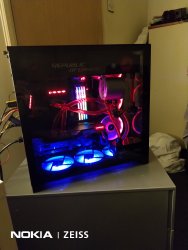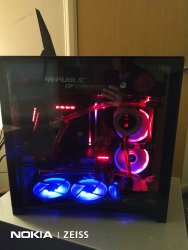Poor cable management can hurt airflow, sure. Dust is probably a bigger problem, though. And then, there's just the matter of how seriously you take things. I mean... imagine telling someone you build PC's and then when they're interested in seeing what you do, you have to show them your dusty, thrown-together rats nest. To me that's kind of embarrassing. I dunno. That might not be everyone, specifically you at your age... but I can tell you I have gotten some pretty nicely paying commissions after showing people my builds and having them be impressed at how clean they are. Good cable management is such a little, almost inconsequential thing, but it does send the message that you know what you're doing and you take pride in what you do. It's not a matter of glamor like fancy gamer stuff with addressable RGB... it more shows diligence and commitment. With cables properly tucked away and secured, a build looks like it was done with purpose and care.
I just figure for most people, it eventually becomes a little closer to the heart and you find yourself just wanting to do it right, because that's what you do!
I guess as far as that goes, you have to ask yourself if it's an act of passion or simply a means to an end. In the latter case, sure... forget cable management. But if you've put together a custom build and you're not even gonna take measures to keep it clean, such as cable management, I do kind of question that. Why bother if you're not gonna put in the work for it?
I go all the way with my cable management for a few simple reasons. Number one is that it is easy with modern cases. You've got openings, shrouds, tie-points, and spacious back compartments. A lot of them even have pretty useful clips built onto the back sections. There's almost no excuse now. What's maybe 30 minutes of time for the money spent? And as far as having to dismantle for upgrades, to me that comes with the territory of customizing your custom machine. That's just part of it. But either way, most cases have clear paths for every cable running to/from every region, so it's usually fairly easy to keep everything sequestered off. Personally, where I have a lot of cables for different things running parallel, I join them together at different tie points and work them into a group (most cables are pliable enough to stay together just working them with your hands.) This way, if I need to pop out a fan or something, I just cut the tie that tethers my intake fans to my IO cables (meanwhile exhaust is on it's own tie points,) while still leaving those tethered further up. Zip ties are cheap and easy to undo/redo. A small pair of diagonal pliers makes quick work of them, and with patience and a little skill you'll never snip a wire with them. If you plan it right, they'll be minimal anyway. You can use a handful of tie points as an anchor for heavy cables, and then use velcro ties to tether the lighter ones to those. Not so bad.
As for a real practical reason to tie your cables down, it keeps them plugged in! Some are clipped down or just so snug you feel like you'll break the connector if you pull them out wrong. But then you have sata and fan cables, which can easily be jostled out when moving your build or working inside of it. Sometimes they can fall out on their own. Easy way to spend an unnecessary amount of time troubleshooting a nonexistent malfunction. One or two pull ties solves that. And even if they never get disconnected, who's to say the unsecured cables won't pop and flop out here and there? Gets annoying to always be repositioning them.



 and spent hours when removing them later
and spent hours when removing them later






